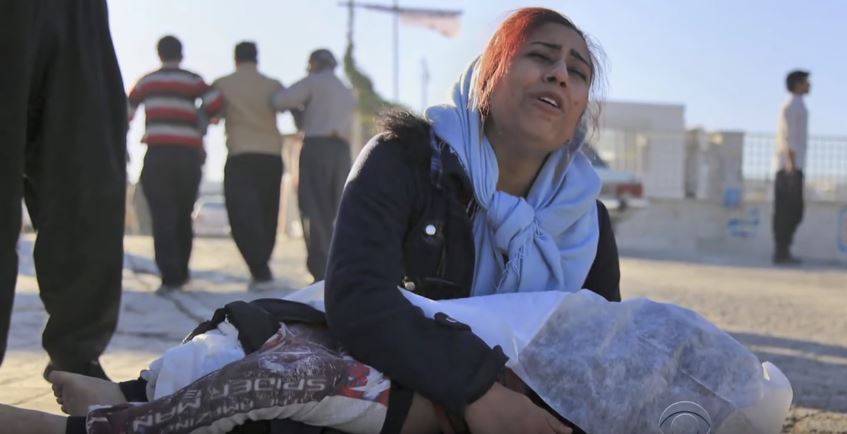On 12 November, a 7.3-magnitude earthquake occurred on the Iran-Iraq border, affecting an area stretching from the Kermanshah Province in northwestern Iran, to Halabja in Iraqi Kurdistan. The whole of the political establishment made statements in support of the victims and the Kurdish areas, with dozens of national papers publishing their front pages in Kurdish. This is supposedly to show their solidarity with the Kurdish masses. Yet the events on the ground paint a clearer picture of the real attitude of the Iranian ruling class.
At least 540 people were killed and more than 8000 injured, though this figure could be an underestimation because many potential casualties from a number of villages have not yet been accounted for. In Iran, almost 2000 villages were hit and severely damaged. According to the IRNA, 12,000 houses were completely destroyed from the earthquakes and 15,000 more were damaged. Furthermore, 70,000+ people are reported to have become homeless.
The region between Iran and Iraq, is prone to more earthquakes as it is near a fault line between the Arabian and Eurasian tectonic plates. As seen in the past couple of years in Iran, major earthquakes are common in this region, with quakes hitting Bam in 2003 and Tabriz in 2012.
In terms of the recent earthquake in Kermanshah, the town of Sarpol-e Zahab suffered the most casualties and infrastructure damage. The total dead just in Sarpol-e Zahab was more than 300, keeping in mind that this figure does not account for several villages that have completely disappeared following the earthquake.
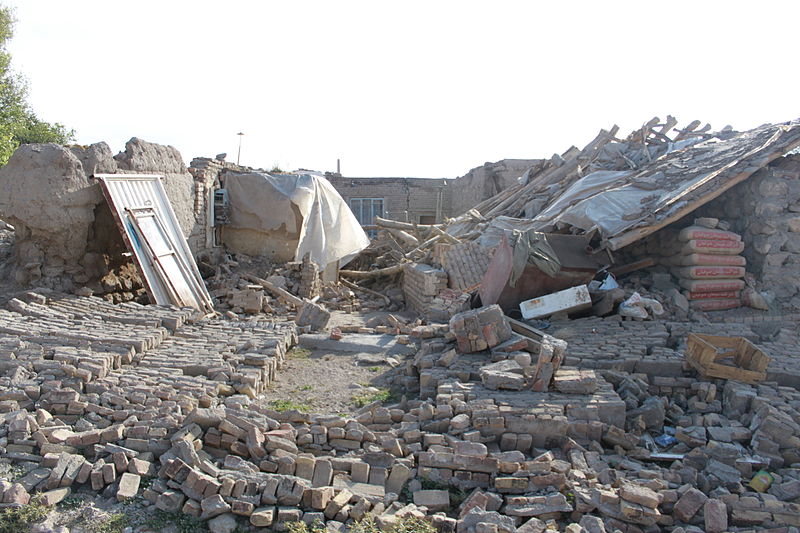
Given the high toll of casualties and injuries, local hospitals and rescues teams were and still are unable to accommodate and treat the hundreds of injured people. Farhad Tajari, the local MP, stated on the local news that “Sarpol-e Zahab has only one hospital, which was demolished in this incident. All patients and hospital staff have been buried beneath the rubble, so it cannot offer any service.” Affected towns nearby like Qasr-e Shirin are still much in ruins and that the number of lost families and villages will likely go up.
Due to the earthquake, electricity was cut off in several Iranian cities nearby which left the victims of the earthquake without shelter or heat in the cold weather. In general the whole rescue effort has been tainted by extreme slowness and disorganization by the government in providing emergency aid. Not only has it underestimated the amount of casualties but has not yet properly provided emergencies services, such as shelter and food and medical care. For instance the soldiers and guards who were sent to check and search through the rubbles at night to find any missing bodies or people, did so without any flashlights.
Shortages of tents, clean mineral water, food and medicine, along with delays in rescuing and uniting families, have resulted in an increase in the level of death as local hospital and rescue centers have either collapsed or do not have enough resources to assist every victim.
One victim in Sarpol-e Zahab, stated that: “Currently, no one has helped. Electricity, water, gas, our telephones are all disconnected. The entire city has been crushed."
یکی از اهالی سرپل ذهاب: فعلا اصلا کمکی نیامده است. برق، آب، گاز و تلفنمان قطع است. شهر کلا داغان شده است.
— روزنامه ایران (@IranNewspaper) November 13, 2017
?: @IranNewspaper @H_Hajipour60 pic.twitter.com/50RYtUwVsi
One resident standing in a street surrounded by collapsed buildings told the New York Times, “There has been no help yet, neither food nor water, no clothing, no tents, there is nothing. There are no facilities yet. We’ve slept outside since last night. This is the condition of our homes. Our electricity, water, gas, phone lines are out, everything is completely out, the whole city has been destroyed, it is wrecked.”
Kermanshah is one of the poorer provinces in Iran and has historically been starved of investments, partly due to its mainly Kurdish population. Hence, its imprint on the Iranian economy is less than 1.5 percent of the GDP. The impact of these policies become even more palpable when events such as the earthquake takes place. In the video below a victim yells out saying that the government officials only came to take selfies of themselves with the damaged buildings and not to help victims with materials since the victims were Kurdish and not Iranians. This reflects a deep sentiment of resentment that many Kurds feel towards the central government.
#کرمانشاە! مردم مناطق زلزلە زدە کرمانشاە پاسخ ادعای دولت مبنی بر کمک را میدھند.
— Ali Javanmardi (@Javanmardi75) November 15, 2017
ئەوەش وڵامی خەڵکی بومەلەرزە لێدراو بە ئیدعای حکومەت:ھاتون بۆ سێلفی گرتن و تەنیا خەلکی کورد یارمەتی داوە. pic.twitter.com/tpUfUJXjXI
The contrast was clear as the government has been appropriating viable rescue equipment for the yearly Arbaeen pilgrimage while the disaster hit areas are in dire need of the same equipment. The below screenshot has been trending on Twitter:
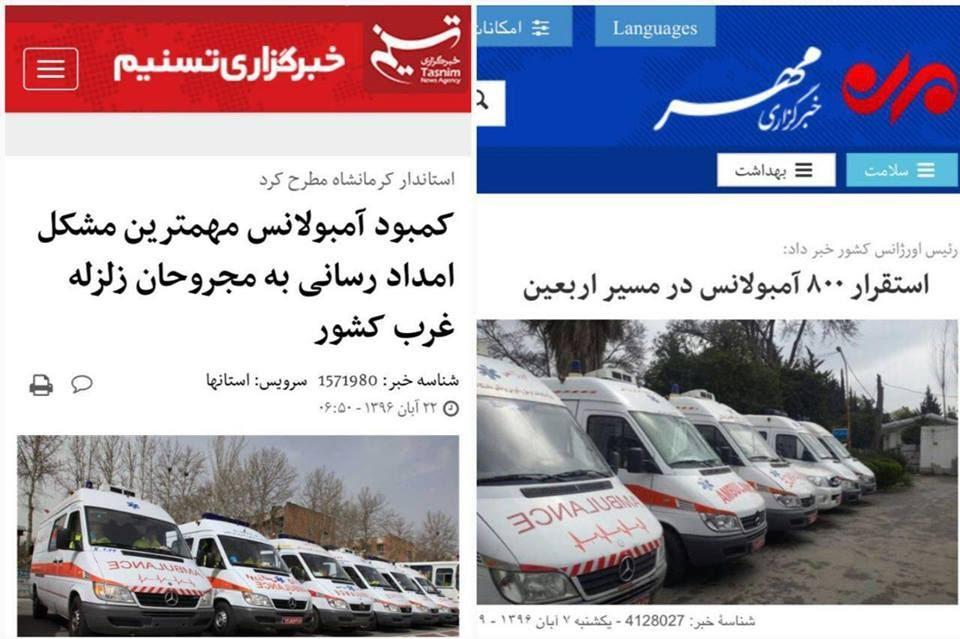 Translation: (from the left): "The most important problem is a lack of ambulances for relief to the injured in the Kermanshah (Western) earthquake." (From the right) "800 ambulances to establish the path for Arbaeen."
Translation: (from the left): "The most important problem is a lack of ambulances for relief to the injured in the Kermanshah (Western) earthquake." (From the right) "800 ambulances to establish the path for Arbaeen."
But the problems did not start with the rescue efforts. The earthquake inflicted massive infrastructural damage as housing complexes and other weakly built structures collapsed.
The ‘Mehr-Housing’, which was constructed under Ahmadinejad’s administration, in a national affordable housing scheme, was severely hit by the quake. Many of these homes were produced cheaply in huge quantities without serious attention being paid to build quality, safety standards and proper seismic design. The reality is that this scheme was a major drainage of public funds into the pockets of government cronies. Little-to-no concern was paid to quality of the build and to the fate of the people who were to use the houses.
The newly built hospitals in Sarpol-e Zahab, such as the Imam Khomeini Hospital, also collapsed immediately following the earthquake, which made it much more difficult for the local rescue teams to properly treat injured victims, as only one hospital was standing after the earthquake. According to the New York Times, it was not just housing complexes and hospitals but other governmental buildings that also collapsed. According to Iranian officials more than 40,000 properties have become uninhabitable, including many newly built state hospitals, schools, apartment complexes and even army barracks.
Many of the victims, who lived in Mehr Housing and other similar complexes, directly blamed government corruption for having shoddy construction and poor planning, which have all resulted in this severe aftermath. At first, during his election campaign, Rouhani severely criticized Ahmadinejad’s Mehr Housing program but seeing the popularity of the idea of cheap housing for the poorest, he had to promise to complete the homes that were promised under the project. It is clear that the Rouhani administration does not have any intention of continuing state funded low-income housing schemes.
After the earthquake it has been harshly critical of the scheme trying to decisively shut the door on similar schemes being taken up in the future. Instead of calling for the building of quality housing for poor and working class families, Rouhani and the establishment are using this disaster as an excuse to abolish affordable housing schemes altogether. Instead, they are tilting increasingly towards government loans and funds to “help low-income groups in cities and towns to build or buy at least 150,000 homes on a yearly basis.”
On this basis the government is inflating the enormous speculative property bubble built up by the Iranian capitalist class. But it is doing so at the expense of poor households who stand to gain nothing but permanent indebtedness. For most poor people, taking out a small home loan also means them unable to pay back on time due to the rising inflation rates and associated interest rates. Meanwhile large construction companies stand to rake in huge profits in an even more blatant manner manner than they did through the Mehr housing project.
Because Iran is geographically prone to earthquakes, the renovation of old buildings is a must. However, there is currently no incentive from property owners to continue the renovation of the old buildings. Most building permits can be bought privately and “developers are allowed to economize on safety regulations and some quality-control inspectors make more of their living from bribes than salaries.” Not only are developers not obliged to follow building safety procedures but also in order to reproduce massive housing and building complexes, such as the Mehr Housing projects, the foundations do not need have a rigid structure that can endure additional resistance. Instead, all of these government-led constructions were all based on unreinforced brick or concrete blocks.
Earlier this year, the collapse of the Plasco Building in Tehran was an example of the many poorly and unmaintained buildings scattered across the nation. The government agencies did not enforce the "22 national building regulations", while property owners did not take charge of renovation. Furthermore, many of the contractors who are supposed to meditate and enforce the regulations were not paid on time so there has been a widespread tendency to ‘cheat’ out of renovating properties and eventually leave the low-paid job; all due to a lack of conscious planning and coordination.
Iran’s decaying infrastructure is not something new. Despite knowing the risks, the Iranian authorities have never taken appropriate preemptive actions in areas such as in Kermanshah and Kerman that are known to be prone to earthquakes. What is in common in these natural disasters is the negligence and corruption of property developers and speculators, eager to make a quick buck with little regard for public safety. These get-rich quick schemes that neglect the maintenance of public infrastructure have only resulted in more damage post-disasters, where it is the shoddy infrastructure rather than the disaster itself that causes the most casualties.
To give one example of the lasting effects of the aftermath from earthquakes: The 2003 Bam Earthquake was a horrific blow to the poorest layers of society. Not only were the victims left homeless and abandoned but also, the inadequate response from the Iranian government to properly manage the aftermath by having ready emergency centers, evacuation and medical services drove many to use opium and heroine as a means to mentally and physically recover from the traumas associated with the earthquake.
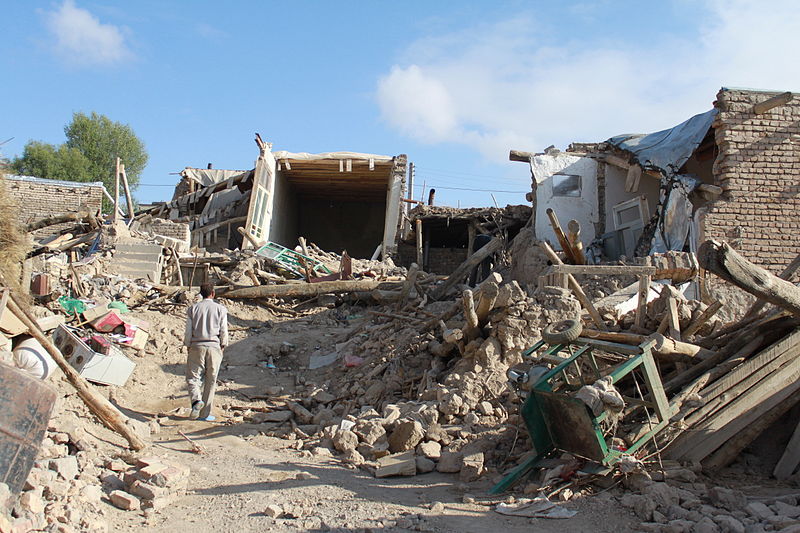
The reason why these disasters have such a severe effect is that there is no conscious planning in dealing with the aftermath. There is nothing natural about the material effects that come out of these disasters. The anarchic laws of the property market mean that property owners can do whatever they want: and it is clear that the interests of these developers are aligned with the interests of the capitalists, which is to make profit.
The Mehr Housing Project was demagogically used to win over votes to the Ahmadinejad government. But instead of actually leading to quality housing, it was used to siphon off public funds into the pockets of middlemen, construction companies and other parasitic capitalist elements. Hence, it has been mired by problems over key aspects such as water, power, and natural gas. This is a general reflection of the state housing and infrastructure throughout Iran where an ever greater race is taking place between different capitalists to pillage the coffins of the state and the pockets of the poor. They have no interest in or intention of actually solving the problems faced by society.
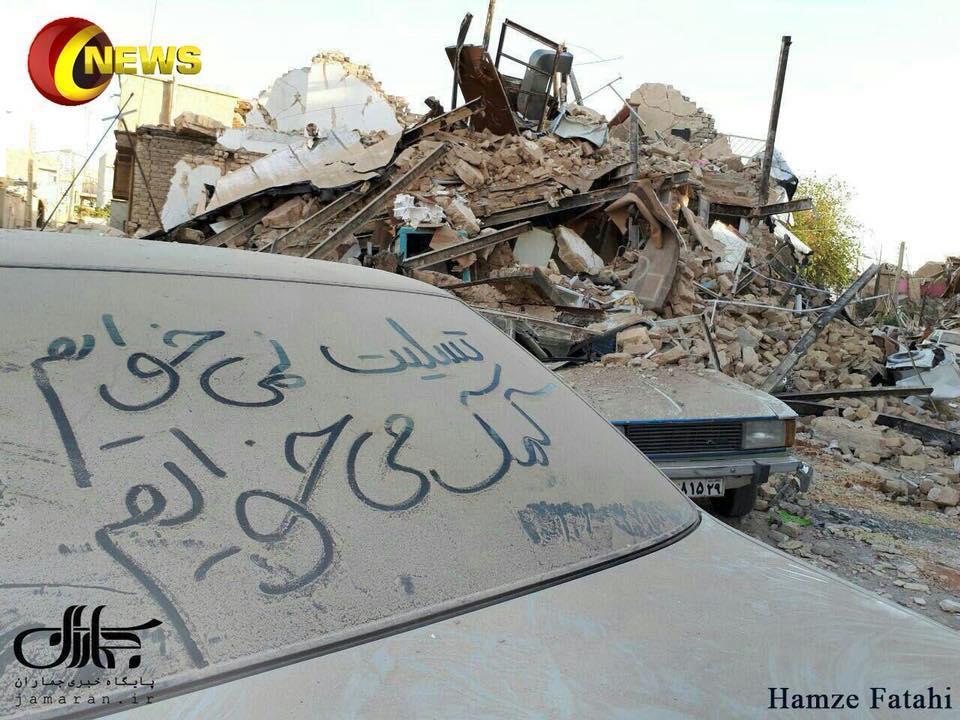 "We do not need thoughts and prayers, we need help." / Image: fair use
"We do not need thoughts and prayers, we need help." / Image: fair use
The responsibility for the scope of death and destruction after the earthquake rests solely with the Iranian ruling class. Just like they could not be trusted to provide proper housing and infrastructure, they cannot be trusted to rebuild the disaster areas either. The reconstruction will be a major beacon for the same parasites looking to make a profit from public spending.
The capitalist class is unable to find a way out of this situation: even if it wanted to. Capitalism is an anarchic system that cannot be regulated or ‘tamed’. Corruption and nepotism are intrinsic to it. The Iranian bourgeoisie are a clear expression of this. Ultimately, the solution to this crisis is the implementation of a democratically planned economy, controlled by the working class, who can use this power to produce and build according to the needs of society. Rosa Luxemburg once said that the question for humanity today is either socialism or barbarism, and disasters such as these reveal the barbarism inflicted by capitalism on the working-class. The need for a socialist transformation of society has never been more imperative for humanity than at the present moment.

